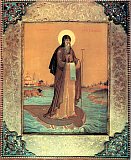

| Previous day | Next day |
| Old Style
July 3
|
Thursday |
New Style
July 16
|
| 6th Week after Pentecost. Tone 4. | No fast.
|
![]() Martyr Hyacinth of Caesarea in Cappadocia (108).
Martyr Hyacinth of Caesarea in Cappadocia (108). ![]() Second translation of the relics of Hieromartyr Philip, metropolitan of Moscow and all Russia (1652).
Second translation of the relics of Hieromartyr Philip, metropolitan of Moscow and all Russia (1652).
Martyrs Diomedes, Eulampius, Asclepiodotus, and Golinduc (2nd c.). Martyrs Mocius and Mark (4th c.). St. Alexander, founder of the Monastery of the Unsleeping Ones, Constantinople (ca. 430). St. Anatolius, patriarch of Constantinople (458). St. Anatolius, recluse, of the Near Caves in Kiev (12th c.) and St. Anatolius (another), recluse, of the Far Caves in Kiev (13th c.). Repose of St. Basil, bishop of Ryazan (1295). Sts. Basil and Constantine, princes of Yaroslavl (13th c.). Sts. John and Longinus of Yarenga, monks of Solovki (1561). Blessed John of Moscow, fool-for-Christ (1589). St. Nicodemus of Khozyuga, monk of Kozhaezersk Monastery (1640). St. Basil, archbishop of Novgorod (1352). Blessed Michael, Herodion, Basil, and Thomas, fools-for-Christ, of Solvychegodsk (17th c.).
New Hieromartyr Anthony (Bystrov), archbishop of Arkhangelsk and Kholmogorsk (1931).
“Milk-Giver” Icon of the Most Holy Theotokos of Hilandar, Mt. Athos.
St. Anatolius, bishop of Laodicea, and his successor, St. Eusebius (3rd c.). St. Germanus, bishop of the Isle of Man and enlightener of Peel, nephew of St. Patrick of Ireland (474). St. Isaiah the Solitary, of Scetis and Palestine (ca. 489). St. Symeon the Stylite (the third), of Cilicia (6th c.). St. George the Godbearer, of the Black Mountain, teacher of St. George of Mt. Athos (1068). St. Joachim, monk, of Notena in Achaia (17th c.). New Monk-martyr Gerasimus the New, of Carpenision, at Constantinople (1812). Martyrs Theodotus and Theodota, martyred with St. Hyacinth at Caesarea in Cappadocia (108).
Repose of Nun Euphrosyne “the Unknown,” of Kolyupanovo (Aleksin) (1855).
Thoughts for Each Day of the Year
According to the Daily Church Readings from the Word of God
By St. Theophan the Recluse

Thursday. [I Cor. 3:18-23; Matt. 13:36-43]
And shall cast them (those who offend and do iniquity) into a furnace of fire: there shall be wailing and gnashing of teeth. Then shall the righteous shine forth as the sun in the Kingdom of their Father. Thus will be carried out the division of good and evil, light and darkness. Now is the period of time in which they are mixed. It pleased the Lord to arrange that the freedom of creatures should grow and be strengthened in good through the struggle with evil; evil is tolerated within the vicinity of inward freedom, and in contact with a person externally. It does not determine anything, only tempts. One who feels a temptation must not fall, but enter into battle. He who conquers is freed from one temptation, and advances forward and upward to find new temptation there—and so on, until the end of his life. Oh, when will we comprehend this meaning of the evil which tempts us, so we might arrange our lives according to this understanding! The strugglers are finally crowned, and pass on to the other life where there is neither sickness nor sorrows from the outside, and where they become inwardly pure like angels of God, free from the sting of tempting inclinations and thoughts. This is how the triumph of light and good is being prepared, and it will be revealed in all of its glory on the last day of the world.
Articles
 Martyr MociusThe Holy Martyrs Mocius and Mark were arrested as Christians and brought to trial by the governor Maximian. |
 Martyr MarkThe Holy Martyrs Mocius and Mark were arrested as Christians and brought to trial by the governor Maximian. |
 St Basil the Bishop of Ryazan |
 Right-believing Prince Basil of Yaroslavl |
 Right-believing Prince Constantine of YaroslavlIn their youth they lost their father, Vsevolod, who fell in battle with the Tatars (Mongols). St Basil, the elder brother, succeeded to the throne. |
 Venerable Nicodemus the Abbot of Kozhe Lake |
 St George the God-BearerSaint George the God-bearer and Recluse labored in the Black Mountains near Antioch during a time when the churches and monasteries there flourished. |










